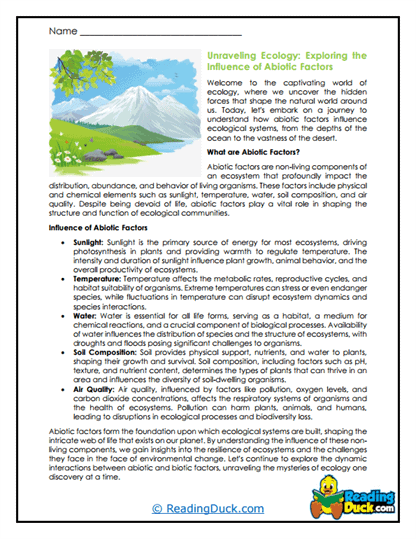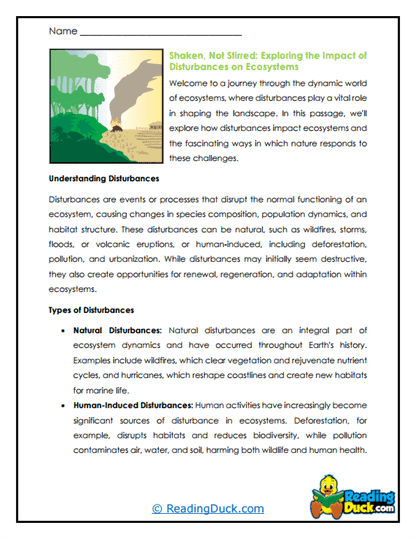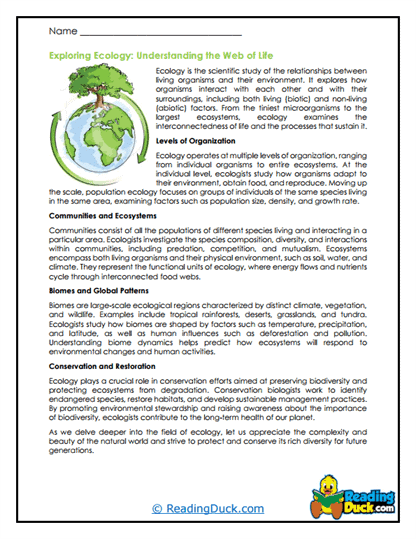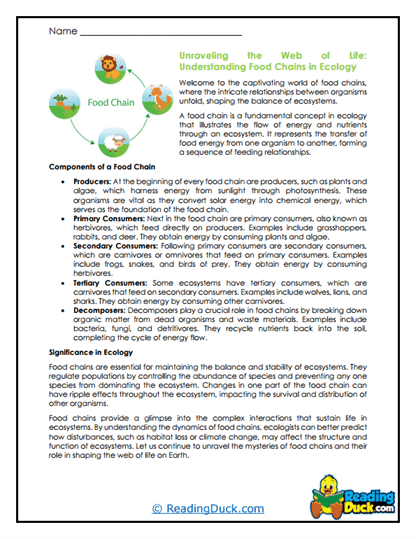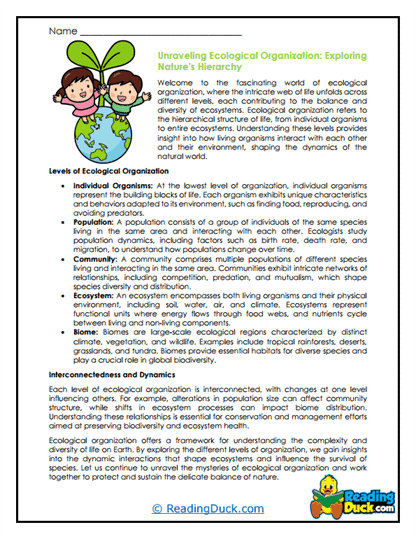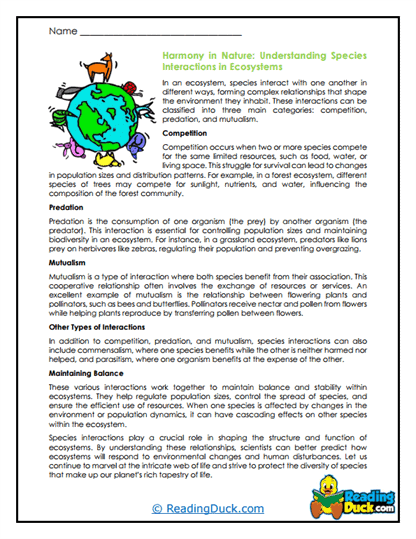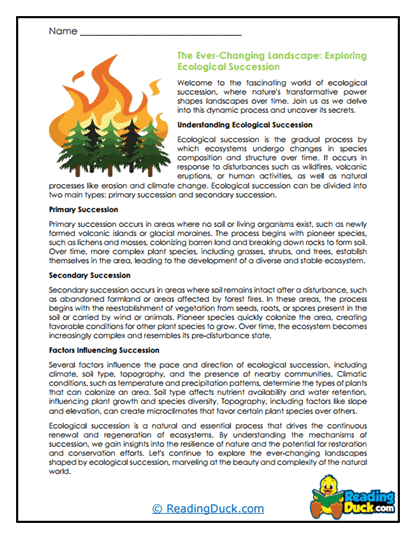Ecology Worksheets
About Our Ecology Worksheets
Our collection of Ecology worksheets offers a comprehensive and engaging exploration of the study of interactions between living organisms and their environment, a fundamental topic within Science: Biology and Environmental Sciences. Ecology is crucial for understanding how ecosystems function, the relationships between different species, and the impact of human activities on the natural world. These worksheets are designed to deepen students' understanding of ecological principles, biodiversity, and the importance of sustainability.
This collection is a subtopic within Biology and Environmental Sciences and contains several worksheet sets. Each worksheet set includes:
- Multiple Choice Questions: These questions assess students' comprehension of the reading passage, ensuring they grasp the key concepts and details presented.
- Short Answer Questions: This section prompts students to write their responses, encouraging them to articulate their understanding in their own words. This exercise helps reinforce their knowledge and improves their ability to communicate scientific information effectively.
- Open-Ended Questions: These questions invite students to share their personal thoughts, opinions, and reflections on the material, fostering critical thinking and allowing them to connect more deeply with the content.
Each worksheet is accompanied by a detailed answer key, making it easy for educators and parents to review students' work. The worksheets are provided in PDF format, ensuring they can be easily viewed electronically, downloaded, and printed.
Exploring Ecology: The Science of Life's Interconnections
Ecology is the branch of biology that deals with the relationships between living organisms and their physical surroundings. It involves studying the interactions within ecosystems, understanding the flow of energy and matter, and examining the balance of natural processes. When introducing students to ecology, it’s important to emphasize the complexity and interconnectedness of life, as well as the role humans play in both disrupting and protecting these systems.
Here’s a closer look at the key areas covered in this collection:
Levels of Ecological Organization: Ecology is often studied at different levels of organization, each offering a unique perspective on how life interacts:
- Organisms: The individual organism is the basic unit of study in ecology. This level focuses on how a single organism interacts with its environment, including its adaptations, behavior, and life processes.
- Populations: A population is a group of individuals of the same species living in a particular area. Population ecology examines factors that affect population size, density, and growth, including birth rates, death rates, and migration patterns.
- Communities: A community consists of all the populations of different species that live and interact in a particular area. Community ecology explores the interactions between species, such as competition, predation, and symbiosis, and how these interactions shape the community structure.
- Ecosystems: An ecosystem includes all the living organisms in a community as well as the non-living components of their environment, such as air, water, and soil. Ecosystem ecology focuses on energy flow, nutrient cycling, and how ecosystems respond to environmental changes.
- Biosphere: The biosphere is the global ecological system integrating all living beings and their relationships, including their interactions with the elements of the atmosphere, hydrosphere, and lithosphere. It is the sum of all ecosystems and represents the zone of life on Earth.
Energy Flow and Nutrient Cycling: Understanding how energy and nutrients move through ecosystems is central to ecology:
- Food Chains and Food Webs: Energy in ecosystems flows from one organism to another through food chains, which show a linear sequence of who eats whom. Food webs are more complex, showing the interconnected feeding relationships within an ecosystem. Producers (plants and algae) form the base of the food chain, while consumers (herbivores, carnivores, omnivores) and decomposers (bacteria and fungi) play crucial roles in recycling nutrients.
- Trophic Levels: Organisms in a food chain are grouped into trophic levels based on their source of energy. Primary producers occupy the first level, followed by primary consumers (herbivores), secondary consumers (carnivores), and tertiary consumers (top predators). Understanding trophic levels helps students grasp the flow of energy and the efficiency of energy transfer between levels.
- Biogeochemical Cycles: Nutrient cycles, such as the carbon, nitrogen, and water cycles, are vital for maintaining the balance of ecosystems. These cycles describe the movement of nutrients through the biosphere, lithosphere, atmosphere, and hydrosphere, and how they are used and recycled by living organisms.
Biodiversity and Ecosystem Stability: Biodiversity is the variety of life in an ecosystem, and it plays a key role in the stability and resilience of ecosystems:
- Species Diversity: High species diversity in an ecosystem can enhance its stability and productivity. Diverse ecosystems are better able to withstand environmental changes and recover from disturbances, such as natural disasters or human activities.
- Ecosystem Services: Biodiversity provides essential ecosystem services, including pollination, water purification, climate regulation, and soil formation. These services are critical for human survival and well-being, and their loss can have significant ecological and economic consequences.
- Conservation and Sustainability: Protecting biodiversity and promoting sustainable practices are crucial for maintaining healthy ecosystems. Conservation efforts focus on preserving habitats, protecting endangered species, and restoring degraded ecosystems. Sustainability involves using resources in a way that meets current needs without compromising the ability of future generations to meet their own needs.
Human Impact on Ecosystems: Human activities have profound effects on ecosystems, often leading to environmental degradation and loss of biodiversity:
- Habitat Destruction: Urbanization, agriculture, deforestation, and mining are major causes of habitat loss. When habitats are destroyed, the species that depend on them may become endangered or extinct, leading to a decrease in biodiversity.
- Pollution: Air, water, and soil pollution can harm ecosystems by introducing toxic substances that disrupt biological processes. For example, pesticides can kill non-target species, and plastic waste can harm marine life.
- Climate Change: Global warming, caused by the buildup of greenhouse gases in the atmosphere, is altering ecosystems around the world. Changes in temperature and precipitation patterns affect the distribution of species, the timing of biological events, and the availability of resources.
- Invasive Species: The introduction of non-native species into new environments can disrupt ecosystems by outcompeting, preying on, or bringing diseases to native species. Invasive species can alter community dynamics and reduce biodiversity.
By exploring these aspects of ecology, students will gain a comprehensive understanding of how ecosystems function, the importance of biodiversity, and the impact of human activities on the environment. These worksheets will guide students through the fundamental concepts of ecology, encouraging them to think critically about the relationships between organisms and their environments and the need for sustainable practices.
Creative Uses For These Worksheets
Here are four creative ideas on how teachers and parents can use these Ecology worksheets in school or in a homeschool setup:
- Ecosystem Exploration Project: Have students create a detailed study of a local ecosystem, such as a forest, wetland, or urban park. They can use the worksheets to identify key species, analyze food chains, and explore human impacts. This project can culminate in a presentation or report that demonstrates their understanding of ecological principles.
- Interactive Food Web Construction: Students can work in groups to construct food webs for different ecosystems using the information from the worksheets. They can create visual diagrams that show the connections between species and their roles within the ecosystem. This activity helps students visualize the complexity of ecological interactions and the importance of each species.
- Role-Playing Environmental Issues: Organize a role-playing activity where students represent different stakeholders in an environmental issue, such as deforestation, pollution, or climate change. The worksheets can provide background information, and students can debate solutions, considering the ecological, economic, and social aspects of the issue.
- Biodiversity Scavenger Hunt: Take students on a field trip to a natural area and organize a biodiversity scavenger hunt. Using the concepts from the worksheets, students can identify different species, categorize them into trophic levels, and discuss their roles in the ecosystem. This hands-on activity fosters a deeper connection to the natural world and reinforces the importance of biodiversity.
The Importance of Learning About Ecology
Understanding ecology is crucial for students because it provides a foundational knowledge of how life on Earth is interconnected and how ecosystems sustain life. Academically, it deepens their understanding of biology, environmental science, and the complex interactions that govern natural systems. On a personal level, learning about ecology empowers students to appreciate the value of biodiversity, recognize the impact of human activities on the environment, and develop a sense of responsibility toward preserving the planet. By understanding the principles of ecology, students are better equipped to make informed decisions and take actions that contribute to a sustainable and healthy environment for future generations.
